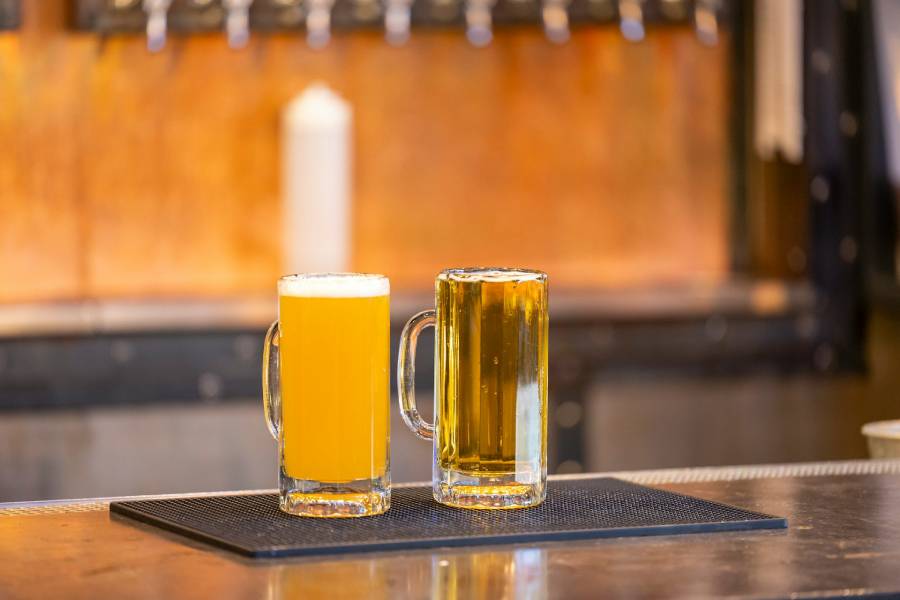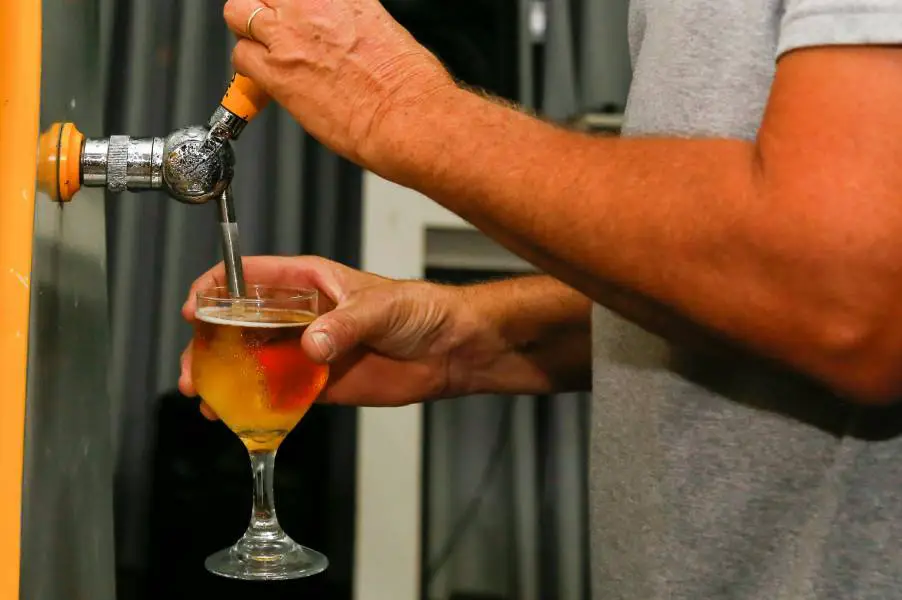The choice between homebrew vs commercial beer can be a tough decision for beer lovers. Both options have their unique appeal, with homebrew offering a personal touch and commercial beer providing consistency. Each has its strengths depending on taste, cost, and experience. Understanding the differences can make all the difference.
Homebrew vs Commercial Beer Overview
Beer is one of the most enjoyed drinks globally and comes in many forms, including homebrew and commercial options. Both are rooted in centuries of tradition, yet offer different experiences for the drinker. Each type has its own community of fans who appreciate specific qualities. This creates a vibrant world of choices for beer lovers.
The brewing process itself is a major point of contrast between the two. While both aim for a flavorful result, the methods and motivations behind them often differ. People are drawn to either homebrew or commercial beer for a variety of reasons. These preferences shape how beer is consumed and appreciated.
Homebrew Beer Overview
Homebrew beer is beer you make at home rather than relying on large-scale breweries. It gives you complete control over the brewing process, allowing you to experiment with ingredients and techniques. You’ll use basic equipment like fermenters, airlocks, yeast, water, flavors, hops, and brewing kettles to get started. This hands-on approach appeals to those who enjoy the craft of creating something unique.
One advantage of homebrewing is the ability to customize flavors and styles. You can add spices, fruit, or adjust hops and malt to create something truly your own. This flexibility lets you explore a wide range of tastes, making each batch a personal creation. For many, the fun comes from both the process and the finished beer.

Brewing beer at home is a simple process that requires little skill to come up with an excellent drink. The process begins by gathering equipment and getting down to work. The following is a step-by-step guide to creating a standard homebrew:
- Malting: Begin with malted grains, usually barley, to prepare the foundation for your beer. The grains are soaked and dried to activate enzymes needed for fermentation.
- Milling: Crush the malted grains to expose the starches inside. This helps the grains release sugars during the brewing process, making them more accessible for conversion.
- Mashing: Mix the milled grains with hot water in a large pot. This allows the enzymes to break down starches into fermentable sugars over about an hour.
- Lautering: Separate the liquid wort from the grain husks. The wort is what you’ll boil, while the grains can be discarded or repurposed for baking or livestock feed.
- Boiling: Bring the wort to a rolling boil, usually for about an hour. Add hops during this step for bitterness, flavor, and aroma, depending on your recipe.
- Cooling: After boiling, cool the wort as quickly as possible using a cooling system like an immersion chiller. This prevents bacteria from spoiling your beer during the next stages.
- Fermenting: Transfer the cooled wort to a fermenter and add yeast. The yeast consumes the sugars, producing alcohol and carbon dioxide over two weeks. Others can take longer.
- Carbonation and packaging: After fermentation, add priming sugar to your beer for carbonation. Finally, bottle or keg your brew, and let it condition before it’s ready to enjoy.
Advantages of Homebrew Beer
- Health benefits: Homebrewed beer contains beneficial nutrients like B vitamins, fiber, and antioxidants often lost in commercial beer due to filtering and processing.
- Customization: Homebrew allows you to customize your beer to your taste preferences. One can experiment with different ingredients, flavors, and styles to create a beer that is unique. For instance, you can add, cinnamon, cardamom, chocolate, or vanilla beans.
- Cost-effective: Brewing beer at home will definitely save you money in the long run. Although the initial cost of buying equipment and ingredients can be high, the cost per pint of homebrew is generally lower than the cost of buying craft beer or commercial beer. You will also brew in bulk, which can last for several weeks (when stored properly).
- Educational: Brewing your own beer is an educational hobby that can teach you about the science and art of brewing. You can learn about the ingredients, equipment needed for brewing, the process involved, and history of beer.
- Social: Homebrewing can be a social activity that brings people together to share and enjoy beer. You can join a homebrewing club or attend beer festivals to meet other homebrewers and beer enthusiasts. This helps you master the art from experienced brewers.

Disadvantages of Homebrewing
- Risk of contamination: Homebrewing requires proper sanitation and cleanliness to prevent beer contamination. It can lead to off-flavors and even make the beer undrinkable if not done correctly.
- Time-consuming process: Brewing beer at home can be time-consuming. The process requires patience and attention to detail. It can take several hours to complete the brewing process and then several weeks to months for the beer to ferment and carbonate properly. So, if you are impatient or committed, the process may consume more of your time.
- Inconsistent results: Homebrewing can be a hit-or-miss experience. At a time the process may be affected by factors such as temperature, yeast health, and the quality of ingredients.
- Sales limitation: Homebrew is only made for personal use as federal law dictates. You may land in trouble when found selling this type of beer.
Commercial Beer
Commercial brewing is the production of beer on a large scale for commercial purposes and is done by brewers or corporations. These breweries and corporates are licensed by the government to sell beer to consumers and wholesalers. The production involves the use of specialized equipment and techniques.

These brewers use automated systems and specialized equipment to handle large volumes of ingredients. Some equipment used includes electric heating, steam boilers, and insulated cooling storage tanks. Commercial brewing also involves more rigorous quality control measures to ensure consistency in the final product. This includes testing the beer at various stages of production to ensure it meets specific standards for taste, aroma, and appearance.
The brewing process is almost similar to homebrewing. It also involves malting, milling, mashing, lautering, boiling, cooling, fermenting, conditioning, and packaging. The only added process is filtration which removes any remaining yeast or other particles, producing a clear, bright beer.
Advantages of Commercial Brewing
- Consistency: Commercial brewing ensures that each batch of beer is consistent in taste, aroma, and quality. This is important for building a brand and establishing a loyal customer base.
- Efficiency: Commercial brewing equipment is designed to handle large quantities of beer so that the brewing process can be completed more efficiently than home brewing.
- Cost-effective: Commercial brewers can decide to lease the brewing equipment instead of buying. This will greatly reduce the brewing cost.
- Regulations: Commercial brewing is subject to strict regulations and quality control standards. The regulations ensures the beer is safe and meets certain quality criteria. So, you can consume these beers without worrying about contamination.
- Distribution: Commercial breweries have established distribution channels that make it easier to get the beer. You can get the beers in bars, restaurants, and retail locations without any hassle.
- Professionalism: Commercial brewing is a professional industry with a range of experts, from brewers to marketers to salespeople. That chain of command ensures the beer is high-quality.
- Varieties: Commercial brewing offers a wide range of beer styles. These brewers offer classic styles like lagers and ales. They also offer more experimental styles like sour beers and barrel-aged beers. This allows beer enthusiasts choose what they like.
Disadvantages of Commercial Brew
- Environmental impact: Large breweries require a significant amount of resources, including water and energy, which can harm the environment.
- Lack of control over ingredients: Consumers have no control over the ingredients used by the breweries, unlike in homebrewing. You just have to consume the beer whether you prefer a particular ingredient or not.
- May be affected by machinery breakdown: A machinery breakdown can lead to huge losses, especially when there is no back-up.
Comparison Between Homebrew and Commercial Beer
These two types of beer have similarities and differences worth noting before deciding what to consume. The following are some of the differences and similarities:
Similarities
- Both are made using similar ingredients, such as malted barley, hops, water, and yeast.
- Both require careful attention to the brewing process to ensure quality and consistency.
- Both can be enjoyed in various styles, from light lagers to rich stouts and everything in between.
- Both can be packaged and stored for later consumption. They can be stored in bottles, cans, or kegs.
- Both can be shared with friends and family as a way of socializing and celebrating special occasions.
- Both pair well with various foods, such as grilled meat, seafood, spicy foods, and cheddar cheese
- Both can be contaminated by bacteria if not handled properly. This can affect the beer’s flavor, aroma, and overall taste.
Differences
- Commercial brewing uses specialized equipment and techniques not typically used in homebrewing.
- Homebrewing is typically done on a smaller scale, unlike commercial brewing, which involves large batches of beer.
- Commercial breweries often have more consistent quality control measures, whereas homebrewed beer may have more variation from batch to batch.
- Homebrewers have more flexibility to experiment with unique ingredients and flavor combinations. On the other hand, commercial breweries may need to stick to tried-and-true recipes to meet consumer demand.
- Commercial breweries may use more advanced technology, to streamline the process and increase efficiency.
- Homebrewing can be a hobby or a passion project, while commercial brewing is typically a business venture with financial considerations.
The Major Distinguishing Factor
The main difference between homebrew and commercial beer is scale and control. Homebrew allows for personal experimentation and small-batch customization. Commercial beer is mass-produced for consistency and wide distribution. While homebrewers focus on creativity, commercial brewers prioritize uniformity to meet consumer demand across large markets.
When to Consume Homebrew Beer
The best time to consume homebrew beer is when you want a beer that is more healthy and has been customized to fulfill your taste preferences. It’s great after the fermentation process is complete and the flavors have developed. Fresh homebrew offers a unique, handcrafted experience. Enjoy it when you crave something personal and tailored.
When to Consume Commercial Beer
The best time to consume commercial beer is when you don’t have time or knowledge to brew your own. It’s convenient, consistent, and readily available. You can enjoy it fresh from the store, especially for light styles. Commercial beer is perfect when you need a reliable option for any occasion.
Which Beer Is Better: Homebrew vs Commercial Beer?
The best option between homebrew beer and commercial beer is definitely homebrew. It allows for unique flavor combinations and personal experimentation. While commercial beer offers convenience and consistency, nothing compares to the creativity of a homemade brew.

Frequently Asked Questions
Why Is My Homebrew So Carbonated?
Homebrew could be over-carbonated due to using too much carbonation sugar, bottling the beer too soon, or using poor quality yeast. Make sure you use yeast that is good for for your beer. For instance, use a bottom-fermenting yeast if you are brewing lager beer. If you are brewing ale beer, use a top-fermenting yeast.
How Can Brewers Mitigate the Risk of Machinery Breakdown?
The best way brewers can curb the menace of machinery breakdown is by conducting regular inspections and a diligent maintenance. This will help identify the problem at an early stage and prevent any issue that could arise. Other ways to ensure the machines are up and running includes regular cleaning, or take a brewery insurance.
What Is the White Stuff Floating in My Homebrew?
The white stuff floating in your homebrew may be yeast rafts. The yeast rafts are clumps of yeast that float to the top of the beer during fermentation and are a normal byproduct of the process. Do not panic when you see this stuff (krausen/yeast or protein) because it is normal. They indicate that brewing is taking place.
Conclusion
Both homebrew and commercial beer have their own unique advantages and disadvantages. Home made beer gives homebrewer a chance to experiment with different ingredients. On the other hand, commercial beer offers consistency and convenience. This allows beer lovers to consume what they prefer in a responsible way.











